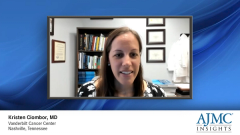
Social Determinants Contributing to Colorectal Cancer Risk
Ryan Haumschild, PharmD, MS, MBA, reviews risk factors for colorectal cancer, including social determinants and at-risk demographics.
Episodes in this series

Ryan Haumschild, PharmD, MS, MBA: When we think about the social determinants of health in colorectal cancer, there are a number of things we want to focus on. We think of social determinants of health in the way that we can focus on access, screening, diagnosis, and treatment. Some of those might be the patient’s stage at diagnosis, their survival, their income, their education, and even the neighborhood they come from. Because when we look at some of our patients with colorectal cancer, you can see what their entire life span or survival looks like based on the zip code of where they live. That’s so important.
We also want to look at the patients’ social support, background, socioeconomic status, and social network. We want to focus on those and consider all those unique backgrounds when we’re treating these patients and providing services to them. Knowing that these patients might be disadvantaged or have different backgrounds, you also want to think about how we overcome some of those barriers we spoke about.
In other words, how do we overcome the neighborhood that a patient is from? They might have a high vulnerability related to transportation, so how do we focus on providing better transportation? How do we focus on providing an agent to a patient who may not do as great with adherence because of their location or socioeconomic background in terms of their home life or job stability? How do we work with those for those unique patients? That’s where care pathways come into play. [Bringing in] a social worker who works directly with that patient to focus on those issues can help to overcome hurdles, like an Uber to their appointments, infusions, or general screenings to make sure they stay on therapy for the life span of their treatment.
There are a number of characteristics around the geographic distribution of colorectal cancer. We see this across the country. From my perspective, we have a higher incidence of colorectal cancer in the Southeast or the South, and it bleeds into the Midwest. One reason for that is you see a larger population of African Americans and Hispanic Americans in that area. According to literature, they tend to have a higher incidence of colorectal cancer and lower survival among all stages of patients who are affected with colorectal cancer.
Knowing that the incidence is consolidated more in the South and the Midwest, how does this affect patient outcomes? When we think about social determinants of health, how can we improve outcomes? We know that there are higher mortality rates. That’s something we’re hyper-focused on. How do we improve those mortality rates? How do we do that through prevention and a number of strategies? But we also know that you unfortunately have higher mortality. You also have more detection needed. A lot of patients aren’t detected until they’re in that metastatic range, or when treatment might be 1 of the last options available for them. How do we encourage more prevention, specifically around those more condensed patient populations?
We know that patients in certain regions, like in the Southeast, South, or Midwest, are at higher risk for colorectal cancer. We want to identify this. We try to do it sometimes through their background by asking them questions about themselves, because we need to screen patients earlier. We need to screen them on what their diet and lifestyle are like, because we know that certain diet and lifestyle choices can promote things like intestinal inflammation, which sometimes modifies the intestinal microflora and promotes an immune response, which can potentially cause polyp growth or eventually convert to cancer. That’s something that we want to be aware of.
We try to identify those patients early on, identify their diet and history, and recognize that they might be at higher risk. When we identify lifestyle modifications, identify them early, or colorectal screen those patients and then leverage the power of genomic testing, it provides more promise with treatments for colorectal cancer and even prevention. Because if we look at the data for colorectal cancer per 100,000 patients in the 1970s, it was around 60% for African Americans and around 50% for White people. But in 2015, the rates were closer to 44% and 36%, so we want to continue to reduce that proportion of patients who are showing up with colorectal cancer. That involves a lot more identification with genomics, lifestyle, and diet.
Transcript edited for clarity.
Newsletter
Stay ahead of policy, cost, and value—subscribe to AJMC for expert insights at the intersection of clinical care and health economics.
















































